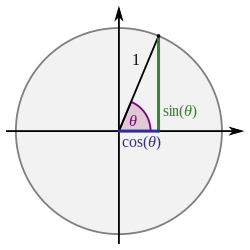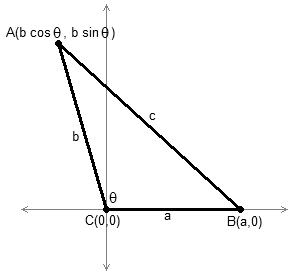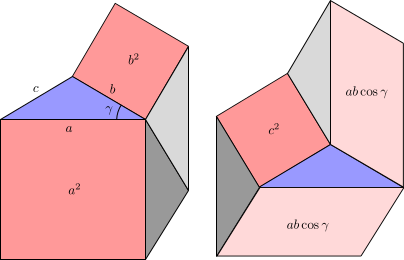| Revision as of 23:42, 11 June 2019 editAnomieBOT (talk | contribs)Bots6,589,597 editsm Dating maintenance tags: {{Fact}}← Previous edit | Revision as of 23:39, 3 July 2019 edit undo82.132.225.35 (talk)No edit summaryNext edit → | ||
| Line 3: | Line 3: | ||
| {{Trigonometry}} | {{Trigonometry}} | ||
| In ], the '''law of cosines''' (also known as the '''cosine formula''', '''cosine rule''', or '''Al-Kashi's theorem'''{{fact|date=June 2019}}) relates the lengths of the sides of a ] to the ] of one of its ]s. Using notation as in Fig. 1, the law of cosines states | In ], the '''law of cosines''' (also known as the '''cosine formula''', '''cosine rule''', or '''Al-Kashi's theorem'''{{fact|date=June 2019}}) relates the lengths of the sides of a ] to the ] of one of its ]s. Using notation as in Fig. 1, the law of cosines states | ||
| :<math>c^2 = a^2 + b^2 - 2ab\cos\gamma,</math> | :<math>c^2 = a^2 + b^2 - 2ab\cos(\gamma),</math> | ||
| where {{math|''γ''}} denotes the angle contained between sides of lengths {{math|''a''}} and {{math|''b''}} and opposite the side of length {{math|''c''}}. For the same figure, the other two relations are analogous: | where {{math|''γ''}} denotes the angle contained between sides of lengths {{math|''a''}} and {{math|''b''}} and opposite the side of length {{math|''c''}}. For the same figure, the other two relations are analogous: | ||
| :<math>a^2=b^2+c^2-2bc\cos\alpha,</math> | :<math>a^2=b^2+c^2-2bc\cos(\alpha),</math> | ||
| :<math>b^2=a^2+c^2-2ac\cos\beta.</math> | :<math>b^2=a^2+c^2-2ac\cos(\beta).</math> | ||
| The law of cosines generalizes the ], which holds only for ]: if the angle {{math|''γ''}} is a right angle (of measure 90 ], or {{sfrac|{{pi}}|2}} ]s), then {{math|cos ''γ'' {{=}} 0}}, and thus the law of cosines ] to the ]: | The law of cosines generalizes the ], which holds only for ]: if the angle {{math|''γ''}} is a right angle (of measure 90 ], or {{sfrac|{{pi}}|2}} ]s), then {{math|cos ''γ'' {{=}} 0}}, and thus the law of cosines ] to the ]: | ||
Revision as of 23:39, 3 July 2019
This article is about the law of cosines in Euclidean geometry. For the cosine law of optics, see Lambert's cosine law.
| Trigonometry |
|---|
 |
| Reference |
| Laws and theorems |
| Calculus |
| Mathematicians |
In trigonometry, the law of cosines (also known as the cosine formula, cosine rule, or Al-Kashi's theorem) relates the lengths of the sides of a triangle to the cosine of one of its angles. Using notation as in Fig. 1, the law of cosines states
where γ denotes the angle contained between sides of lengths a and b and opposite the side of length c. For the same figure, the other two relations are analogous:
The law of cosines generalizes the Pythagorean theorem, which holds only for right triangles: if the angle γ is a right angle (of measure 90 degrees, or π/2 radians), then cos γ = 0, and thus the law of cosines reduces to the Pythagorean theorem:
The law of cosines is useful for computing the third side of a triangle when two sides and their enclosed angle are known, and in computing the angles of a triangle if all three sides are known.
History

Though the notion of the cosine was not yet developed in his time, Euclid's Elements, dating back to the 3rd century BC, contains an early geometric theorem almost equivalent to the law of cosines. The cases of obtuse triangles and acute triangles (corresponding to the two cases of negative or positive cosine) are treated separately, in Propositions 12 and 13 of Book 2. Trigonometric functions and algebra (in particular negative numbers) being absent in Euclid's time, the statement has a more geometric flavor:
Proposition 12
— Euclid's Elements, translation by Thomas L. Heath.
In obtuse-angled triangles the square on the side subtending the obtuse angle is greater than the squares on the sides containing the obtuse angle by twice the rectangle contained by one of the sides about the obtuse angle, namely that on which the perpendicular falls, and the straight line cut off outside by the perpendicular towards the obtuse angle.
Using notation as in Fig. 2, Euclid's statement can be represented by the formula
This formula may be transformed into the law of cosines by noting that CH = (CB) cos(π − γ) = −(CB) cos γ. Proposition 13 contains an entirely analogous statement for acute triangles.
Euclid's Elements paved the way for the discovery of law of cosines. In the 15th century, Jamshīd al-Kāshī, a Persian mathematician and astronomer, provided the first explicit statement of the law of cosines in a form suitable for triangulation. He provided accurate trigonometric tables and expressed the theorem in a form suitable for modern usage. In France, the law of cosines is still referred to as the Théorème d'Al-Kashi.
The theorem was popularized in the Western world by François Viète in the 16th century. At the beginning of the 19th century, modern algebraic notation allowed the law of cosines to be written in its current symbolic form.
Applications

The theorem is used in triangulation, for solving a triangle or circle, i.e., to find (see Figure 3):
- the third side of a triangle if one knows two sides and the angle between them:
- the angles of a triangle if one knows the three sides:
- the third side of a triangle if one knows two sides and an angle opposite to one of them (one may also use the Pythagorean theorem to do this if it is a right triangle):
These formulas produce high round-off errors in floating point calculations if the triangle is very acute, i.e., if c is small relative to a and b or γ is small compared to 1. It is even possible to obtain a result slightly greater than one for the cosine of an angle.
The third formula shown is the result of solving for a in the quadratic equation a − 2ab cos γ + b − c = 0. This equation can have 2, 1, or 0 positive solutions corresponding to the number of possible triangles given the data. It will have two positive solutions if b sin γ < c < b, only one positive solution if c = b sin γ, and no solution if c < b sin γ or c ≥ b. These different cases are also explained by the side-side-angle congruence ambiguity.
Proofs
Using the distance formula

Consider a triangle with sides of length a, b, c, where θ is the measurement of the angle opposite the side of length c. This triangle can be placed on the Cartesian coordinate system by plotting the following points, as shown in Fig. 4:
By the distance formula, we have
Now, we just work with that equation:
An advantage of this proof is that it does not require the consideration of different cases for when the triangle is acute, right, or obtuse.
Using trigonometry

Dropping the perpendicular onto the side c through point C, an altitude of the triangle, shows (see Fig. 5)
(This is still true if α or β is obtuse, in which case the perpendicular falls outside the triangle.) Multiplying through by c yields
Considering the two other altitudes of the triangle yields
Adding the latter two equations gives
Subtracting the first equation from the last one results in
which simplifies to
This proof uses trigonometry in that it treats the cosines of the various angles as quantities in their own right. It uses the fact that the cosine of an angle expresses the relation between the two sides enclosing that angle in any right triangle. Other proofs (below) are more geometric in that they treat an expression such as a cos γ merely as a label for the length of a certain line segment.
Many proofs deal with the cases of obtuse and acute angles γ separately.
Using the Pythagorean theorem

Case of an obtuse angle
Euclid proves this theorem by applying the Pythagorean theorem to each of the two right triangles in the figure shown (AHB and CHB). Using d to denote the line segment CH and h for the height BH, triangle AHB gives us
and triangle CHB gives
Expanding the first equation gives
Substituting the second equation into this, the following can be obtained:
This is Euclid's Proposition 12 from Book 2 of the Elements. To transform it into the modern form of the law of cosines, note that
Case of an acute angle
Euclid's proof of his Proposition 13 proceeds along the same lines as his proof of Proposition 12: he applies the Pythagorean theorem to both right triangles formed by dropping the perpendicular onto one of the sides enclosing the angle γ and uses the binomial theorem to simplify.

Another proof in the acute case
Using more trigonometry, the law of cosines can be deduced by using the Pythagorean theorem only once. In fact, by using the right triangle on the left hand side of Fig. 6 it can be shown that:
using the trigonometric identity
This proof needs a slight modification if b < a cos(γ). In this case, the right triangle to which the Pythagorean theorem is applied moves outside the triangle ABC. The only effect this has on the calculation is that the quantity b − a cos(γ) is replaced by a cos(γ) − b. As this quantity enters the calculation only through its square, the rest of the proof is unaffected. However, this problem only occurs when β is obtuse, and may be avoided by reflecting the triangle about the bisector of γ.
Referring to Fig. 6 it is worth noting that if the angle opposite side a is α then:
This is useful for direct calculation of a second angle when two sides and an included angle are given.
Using Ptolemy's theorem

Referring to the diagram, triangle ABC with sides AB = c, BC = a and AC = b is drawn inside its circumcircle as shown. Triangle ABD is constructed congruent to triangle ABC with AD = BC and BD = AC. Perpendiculars from D and C meet base AB at E and F respectively. Then:
Now the law of cosines is rendered by a straightforward application of Ptolemy's theorem to cyclic quadrilateral ABCD:
Plainly if angle B is right, then ABCD is a rectangle and application of Ptolemy's theorem yields the Pythagorean theorem:
By comparing areas
One can also prove the law of cosines by calculating areas. The change of sign as the angle γ becomes obtuse makes a case distinction necessary.
Recall that
- a, b, and c are the areas of the squares with sides a, b, and c, respectively;
- if γ is acute, then ab cos γ is the area of the parallelogram with sides a and b forming an angle of γ′ = π/2 − γ;
- if γ is obtuse, and so cos γ is negative, then −ab cos γ is the area of the parallelogram with sides a and b forming an angle of γ′ = γ − π/2.

Acute case. Figure 7a shows a heptagon cut into smaller pieces (in two different ways) to yield a proof of the law of cosines. The various pieces are
- in pink, the areas a, b on the left and the areas 2ab cos γ and c on the right;
- in blue, the triangle ABC, on the left and on the right;
- in grey, auxiliary triangles, all congruent to ABC, an equal number (namely 2) both on the left and on the right.
The equality of areas on the left and on the right gives

Obtuse case. Figure 7b cuts a hexagon in two different ways into smaller pieces, yielding a proof of the law of cosines in the case that the angle γ is obtuse. We have
- in pink, the areas a, b, and −2ab cos γ on the left and c on the right;
- in blue, the triangle ABC twice, on the left, as well as on the right.
The equality of areas on the left and on the right gives
The rigorous proof will have to include proofs that various shapes are congruent and therefore have equal area. This will use the theory of congruent triangles.
Using geometry of the circle
Using the geometry of the circle, it is possible to give a more geometric proof than using the Pythagorean theorem alone. Algebraic manipulations (in particular the binomial theorem) are avoided.

Case of acute angle γ, where a > 2b cos γ. Drop the perpendicular from A onto a = BC, creating a line segment of length b cos γ. Duplicate the right triangle to form the isosceles triangle ACP. Construct the circle with center A and radius b, and its tangent h = BH through B. The tangent h forms a right angle with the radius b (Euclid's Elements: Book 3, Proposition 18; or see here), so the yellow triangle in Figure 8 is right. Apply the Pythagorean theorem to obtain
Then use the tangent secant theorem (Euclid's Elements: Book 3, Proposition 36), which says that the square on the tangent through a point B outside the circle is equal to the product of the two lines segments (from B) created by any secant of the circle through B. In the present case: BH = BC·BP, or
Substituting into the previous equation gives the law of cosines:
Note that h is the power of the point B with respect to the circle. The use of the Pythagorean theorem and the tangent secant theorem can be replaced by a single application of the power of a point theorem.

Case of acute angle γ, where a < 2b cos γ. Drop the perpendicular from A onto a = BC, creating a line segment of length b cos γ. Duplicate the right triangle to form the isosceles triangle ACP. Construct the circle with center A and radius b, and a chord through B perpendicular to c = AB, half of which is h = BH. Apply the Pythagorean theorem to obtain
Now use the chord theorem (Euclid's Elements: Book 3, Proposition 35), which says that if two chords intersect, the product of the two line segments obtained on one chord is equal to the product of the two line segments obtained on the other chord. In the present case: BH = BC·BP, or
Substituting into the previous equation gives the law of cosines:
Note that the power of the point B with respect to the circle has the negative value −h.

Case of obtuse angle γ. This proof uses the power of a point theorem directly, without the auxiliary triangles obtained by constructing a tangent or a chord. Construct a circle with center B and radius a (see Figure 9), which intersects the secant through A and C in C and K. The power of the point A with respect to the circle is equal to both AB − BC and AC·AK. Therefore,
which is the law of cosines.
Using algebraic measures for line segments (allowing negative numbers as lengths of segments) the case of obtuse angle (CK > 0) and acute angle (CK < 0) can be treated simultaneously.
Using the law of sines
By using the law of sines and knowing that the angles of a triangle must sum to 180 degrees, we have the following system of equations (the three unknowns are the angles):
Then, by using the third equation of the system, we obtain a system of two equations in two variables:
where we have used the trigonometric property that the sine of a supplementary angle is equal to the sine of the angle.
Using the identity (see Angle sum and difference identities)
leads to
By dividing the whole system by cos γ, we have:
Hence, from the first equation of the system, we can obtain
By substituting this expression into the second equation and by using
we can obtain one equation with one variable:
By multiplying by (b − c cos α), we can obtain the following equation:
This implies
Recalling the Pythagorean identity, we obtain the law of cosines:
Isosceles case
When a = b, i.e., when the triangle is isosceles with the two sides incident to the angle γ equal, the law of cosines simplifies significantly. Namely, because a + b = 2a = 2ab, the law of cosines becomes
or
Analogue for tetrahedra
An analogous statement begins by taking α, β, γ, δ to be the areas of the four faces of a tetrahedron. Denote the dihedral angles by etc. Then
Version suited to small angles
When the angle, γ, is small and the adjacent sides, a and b, are of similar length, the right hand side of the standard form of the law of cosines can lose a lot of accuracy to numerical loss of significance. In situations where this is an important concern, a mathematically equivalent version of the law of cosines, similar to the haversine formula, can prove useful:
In the limit of an infinitesimal angle, the law of cosines degenerates into the circular arc length formula, c = a γ.
In spherical and hyperbolic geometry
Main articles: Spherical law of cosines and Hyperbolic law of cosines
Versions similar to the law of cosines for the Euclidean plane also hold on a unit sphere and in a hyperbolic plane. In spherical geometry, a triangle is defined by three points u, v, and w on the unit sphere, and the arcs of great circles connecting those points. If these great circles make angles A, B, and C with opposite sides a, b, c then the spherical law of cosines asserts that both of the following relationships hold:
In hyperbolic geometry, a pair of equations are collectively known as the hyperbolic law of cosines. The first is
where sinh and cosh are the hyperbolic sine and cosine, and the second is
As in Euclidean geometry, one can use the law of cosines to determine the angles A, B, C from the knowledge of the sides a, b, c. In contrast to Euclidean geometry, the reverse is also possible in both non-Euclidean models: the angles A, B, C determine the sides a, b, c.
Unified formula for surfaces of constant curvature
Defining two functions and as
- and
allows to unify the formulae for plane, sphere and pseudosphere into:
In this notation is a complex number, representing the surface's radius of curvature.
- For the surface is a sphere of radius , and its constant curvature equals
- for the surface is a pseudosphere of (imaginary) radius with constant curvature equal to
- for : the surface tends to a Euclidean plane, with constant zero curvature.
Verifying the formula for non-Euclidean geometry
In the first two cases, and are well-defined over the whole complex plane for all , and retrieving former results is straightforward.
Hence, for a sphere of radius
- .
Likewise, for a pseudosphere of radius
Indeed, and
Verifying the formula in the limit of Euclidean geometry
In the Euclidean plane the appropriate limits for the above equation must be calculated:
and
- .
Applying this to the general formula for a finite yields:
Collecting terms, multiplying with and taking yields the expected formula:
See also
- Half-side formula
- Law of sines
- Law of tangents
- Law of cotangents
- List of trigonometric identities
- Mollweide's formula
- Solution of triangles
- Triangulation
References
- "Euclid, Elements Thomas L. Heath, Sir Thomas Little Heath, Ed". Retrieved 3 November 2012.
- Clifford A. Pickover (2009). The Math Book: From Pythagoras to the 57th Dimension, 250 Milestones in the History of Mathematics. p. 106.
- Computing : a historical and technical perspective. Igarashi, Yoshihide,. Boca Raton, Florida. p. 78. ISBN 9781482227413. OCLC 882245835.
{{cite book}}: CS1 maint: extra punctuation (link) CS1 maint: others (link) - Ilija Baruk (2008). Causality I. A Theory of Energy, Time and Space, Volume 2. p. 174.
- Java applet version by Prof. D E Joyce of Clark University.
- Casey, John (1889). A Treatise on Spherical Trigonometry: And Its Application to Geodesy and Astronomy with Numerous Examples. London: Longmans, Green, & Company. p. 133.
External links
- "Cosine theorem", Encyclopedia of Mathematics, EMS Press, 2001
- Several derivations of the Cosine Law, including Euclid's at cut-the-knot
- Interactive applet of Law of Cosines
























































 etc. Then
etc. Then





 and
and  as
as
 and
and 

 is a
is a  the surface is a
the surface is a 
 the surface is a
the surface is a  with constant curvature equal to
with constant curvature equal to 
 : the surface tends to a Euclidean
: the surface tends to a Euclidean  , and retrieving former results is straightforward.
, and retrieving former results is straightforward.

 .
.

 and
and 

 .
.
 and taking
and taking 